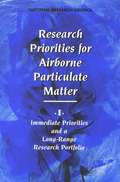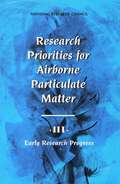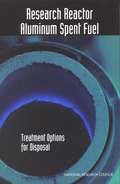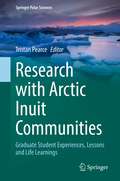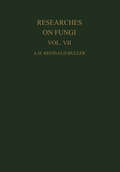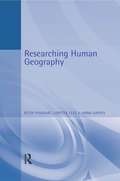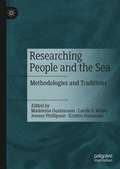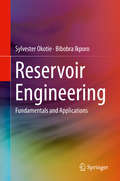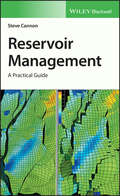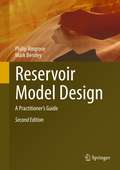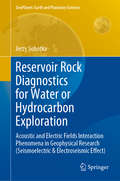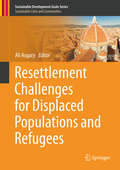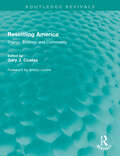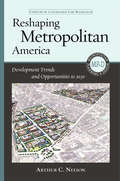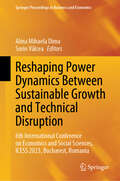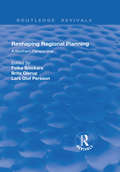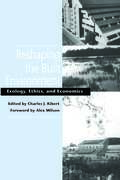- Table View
- List View
Research Priorities for Airborne Particulate Matter, Volume I: Immediate Priorities and a Long-Range Research Portfolio
by Committee on Research Priorities for Airborne Particulate MatterNew National Ambient Air Quality Standards for airborne particles smaller than 2.5 micrometers, called PM2.5, were issued by the U.S. Environmental Protection Agency (EPA) amidst scientific uncertainty and controversy. In response to a request from Congress, Research Priorities for Airborne Particulate Matter, the first of four books in a series, offers a conceptual framework for an integrated national program of particulate-matter research, identifies the 10 most critical research needs linked to key policy-related scientific uncertainties, and describes the recommended timing and estimated costs of such research.The committee concludes that EPA should devote more resources to investigating the relationships between fixed-site outdoor monitoring data and actual human breathing-zone exposures to ambient particulate matter and to identifying the most biologically important constituents and characteristics of particulate matter through toxicological studies. The recommended research activities are critical to determining actual exposures of human subpopulations most susceptible to harm from the most hazardous constituents of particulate matter. Future research will be an investment in public health and a means to ensure that resources spent on control technology and regulatory compliance will have a reasonable probability of success.
Research Priorities for Airborne Particulate Matter, Volume II
by Committee on Research Priorities for Airborne Particulate MatterIn the effort to reduce the scientific and technical uncertainties over regulation of airborne particulate matter in the United States, Research Priorities for Airborne Particulate Matter: II. Evaluating Research Progress and Updating the Portfolio, the second book in a four-part series requested by Congress, describes the plans of the committee to monitor the progress of the research on particulate matter conducted by the U.S. Environmental Protection Agency (EPA), other federal and state government agencies, and nongovernmental organizations.The book also reviews and updates the committee's portfolio of recommended research in its first volume, Research Priorities for Airborne Particulate Matter: I. Immediate Priorities and a Long-Range Research Portfolio (NRC, 1998). The committee substantially revised two of the ten high-priority research areas recommended in Part I. Part II notes that Congress, EPA, and the scientific community have given strong support to the committee's recommendations and have implemented substantial changes in research efforts in response to Part I of the series. One important research area-studies of the effects of long-term exposure to particulate matter and other major air pollutants-however, does not appear to be underway or planned.
Research Priorities for Airborne Particulate Matter, Volume III
by Committee on Research Priorities for Airborne Particulate MatterRegulatory standards are already on the books at the the U.S. Environmental Protection Agency (EPA) to address health risks posed by inhaling tiny particles from smoke, vehicle exhaust, and other sources. At the same time, Congress and EPA have initiated a multimillion dollar research effort to better understand the sources of these airborne particles, the levels of exposure to people, and the ways that these particles cause damage. To provide independent guidance to the EPA, Congress asked the National Research Council to study the relevant issues. The result is a series of four reports on the particulate-matter research program. The first two books offered a conceptual framework for a national research program, identified the 10 most critical research needs, and described the recommended timing and estimated costs of such research. This, the third volume, begins the task of assessing the progress made in implementing the research program. The National Research Council ultimately concludes that the ongoing program is appropriately addressing many of the key uncertainties. However, it also identifies a number of critical specific subjects that should be given greater attention. Research Priorities for Airborne Particulate Matter focuses on the most current and planned research projects with an eye toward the fourth and final report, which will contain an updated assessment.
Research Priorities for Airborne Particulate Matter, Volume IV
by Committee on Research Priorities for Airborne Particulate MatterIn 1997, the U. S. Environmental Protection Agency (EPA) established regulatory standards to address health risks posed by inhaling tiny particles from smoke, vehicle exhaust, and other sources. At the same time, Congress and the EPA began a multimillion dollar research effort to better understand the sources of these airborne particles, the levels of exposure to people, and the ways that these particles cause disease. To provide independent guidance to the EPA, Congress asked the National Research Council to study the relevant issues. The result was a series of four reports on the particulate-matter research program. The first two books offered a conceptual framework for a national research program, identified the 10 most critical research needs, and described the recommended timing and estimated costs of such research. The third volume began the task of assessing initial progress made in implementing the research program. This, the fourth and final volume, gauged research progress made over a 5-year period on each of the 10 research topics. The National Research Council concludes that particulate matter research has led to a better understanding of the health effects caused by tiny airborne particles. However, the EPA, in concert with other agencies, should continue research to reduce further uncertainties and inform long-term decisions.
Research Reactor Aluminum Spent Fuel: Treatment Options for Disposal
by Board on Radioactive Waste ManagementThe U.S. Department of Energy (DOE) is preparing an environmental impact statement (EIS) for management of aluminum spent fuel from foreign and domestic research reactors, much of which is highly enriched in uranium-235. This EIS will assess the need for additional treatment and storage facilities at the Savannah River Site to accommodate the receipt of this fuel, and it also will assess and select a treatment technology to prepare this fuel for interim storage and eventual shipment to a repository for disposal.This National Research Council book, which was prepared at the request of DOE's Savannah River Office, provides a technical assessment of the technologies, costs, and schedules developed by DOE for eight alternative treatment options and the baseline reprocessing option. It also provides comments on DOE's aluminum spent fuel disposal program, a program that is slated to last for about 40 years and cost in excess of $2 billion.
Research Scientist (Careers With Character #18)
by Shirley BrinkerhoffFind out what it takes to be a research scientist with character... Research scientists work to develop new products and techniques that improve human lives. These scientists can be: *Biochemists; *Botanists; *Marine biologists; *Microbiologists; *Physiologists; or *Zoologists. Whatever their field, researchers investigate ways to heal diseases, create new inventions, and explore the world around us. Professionals in this field need strong backgrounds in science and math--and equally strong characters. When researchers combine their desire to know more about the world with Integrity... Compassion... Diligence... And courage, they make the world a better place for us all to live. Find out about this exciting field. Read Research Scientist.
Research with Arctic Inuit Communities: Graduate Student Experiences, Lessons and Life Learnings (Springer Polar Sciences)
by Tristan PearceThis book shares graduate student experiences, lessons, and life learnings from research with Inuit communities in the Canadian Arctic. The results of graduate student research are often disseminated in a thesis or dissertation, but their personal experiences building relationships with Inuit, working together to design and conduct research, and how this shaped their research approach and outcomes, are rarely captured. As such, there are limited resources available to new researchers that share information about the practical aspects of community-based research in the Arctic. The book is intended to provide a glimpse into what it is like to do research together with Inuit, and in doing so, contribute to the development of more productive and equitable relationships between Inuit and researchers. The chapters are written as structured narratives in the first-person and include reflections, and lessons learned.
Researches on Fungi, Vol. VII: The Sexual Process in the Uredinales
by A. H. BullerThis is the last volume of the late Professor Buller's monumental work on Fungi. Before his death in 1943, Dr. Buller had completed the manuscript; the final preparation for press has been made by Dr. G.R. Bisby of the Imperial Mycological Institute, Kew. Publication of the volume has been sponsored by the Royal Society of Canada, and the work of proofreading undertaken by Dr. W.E. Hanna, Dr. J.H. Craigie, and Dr. F.L. Drayton; the index has been prepared under Dr. Hanna's supervision. A foreword has been contributed by Dr. Joseph A. Pearce, President of the Royal Society.
Researching Human Geography
by Anna Davies Loretta Lees Keith HoggartResearching Human Geography is an essential new text for any geography student about to embark on a research project. An understanding of how different theories of knowledge have influenced research methodologies is crucial in planning and designing effective research; this book makes this link clear and explores how various philosophical positions, from positivism to post-structuralism, have become associated with particular methodologies.The book gives an overview of a wide range of methods and data collection, both quantitative and qualitative, and explores their strengths and weaknesses for different kinds of research. 'Researching Human Geography' also looks at the various techniques available for the analysis of data, which is presented as an integral and ongoing part of the research process. Clearly written, with extensive use of examples from previous research to show 'methodology in action', this new text is an invaluable addition to both the theory and method of research in human geography.
Researching People and the Sea: Methodologies and Traditions
by Madeleine Gustavsson Carole S. White Jeremy Phillipson Kristen OunanianIn this unique edited collection, social scientists reflect upon and openly share insights gathered from researching people and the sea. Understanding how people use, relate to and interact with coastal and marine environments has never been more important, with social scientists having an increasingly vital contribution to make. Yet practical experiences in deploying social science approaches in this field are typically hidden away in field notes and unpublished doctoral manuscripts, with the opportunity for shared learning that comes from doing research often missed. There is a need for reflection on how social science knowledge is produced. This collection presents experiences from the field, its necessary reflexivity and innovation in methods, and the challenges and opportunities of translating across disciplines and policy. It brings to light the tacit expertise needed to study people and the sea and offers lessons which readers could employ in their own research. With a focus on the future direction of marine social sciences, the volume is highly relevant to masters and doctoral students and more experienced researchers engaged in studying people and the sea, as well as policy makers, practitioners and scientists wishing to understand the social dimension of marine and coastal environments. Chapters 2 and 3 are available open access under a Creative Commons Attribution 4.0 International License via link.springer.com.
Reservoir Engineering: Fundamentals and Applications
by Sylvester Okotie Bibobra IkporoThis book provides a clear and basic understanding of the concept of reservoir engineering to professionals and students in the oil and gas industry. The content contains detailed explanations of key theoretic and mathematical concepts and provides readers with the logical ability to approach the various challenges encountered in daily reservoir/field operations for effective reservoir management. Chapters are fully illustrated and contain numerous calculations involving the estimation of hydrocarbon volume in-place, current and abandonment reserves, aquifer models and properties for a particular reservoir/field, the type of energy in the system and evaluation of the strength of the aquifer if present. The book is written in oil field units with detailed solved examples and exercises to enhance practical application. It is useful as a professional reference and for students who are taking applied and advanced reservoir engineering courses in reservoir simulation, enhanced oil recovery and well test analysis.
Reservoir Geomechanics
by Mark D. ZobackA practical reference for geoscientists and engineers in the petroleum and geothermal industries.
Reservoir Management: A Practical Guide
by Steve CannonReservoir management is fundamental to the efficient and responsible means of extracting hydrocarbons, and maximising the economic benefit to the operator, licence holders and central government. All stakeholders have a social responsibility to protect the local population and environment. The process of managing an oil or gas reservoir begins after discovery and continues through appraisal, development, production and abandonment; there is cost associated with each phase and a series of decision gates should be in place to ensure that an economic benefit exists before progress is made. To correctly establish potential value at each stage it is necessary to acquire and analyse data from the subsurface, the planned surface facilities and the contractual obligations to the end-user of the hydrocarbons produced. This is especially true of any improved recovery methods proposed or plans to extend field life. To achieve all the above requires a multi-skilled team of professionals working together with a clear set of objectives and associated rewards. The team’s make-up will change over time, as different skills are required, as will the management of the team, with geoscientists, engineers and commercial analysts needed to address the issues as they arise. This book is designed as a guide for non-specialists involved in the process of reservoir management, which is often treated as a task for reservoir engineers alone: it is a task for all the disciplines involved in turning a exploration success into a commercial asset. Most explorers earn their bonus based on the initial estimates of in-place hydrocarbons, regardless of the ultimate cost of production; the explorers have usually moved on to a new basin before the first oil or gas is produced! This book is not a deeply academic tome, rather the description of a process enlivened by a number of stories and case studies from the author’s forty years of experience in the oil-patch.
Reservoir Model Design: A Practitioner's Guide
by Philip Ringrose Mark BentleyThis book gives practical advice and ready to use tips on the design and construction of subsurface reservoir models. The design elements cover rock architecture, petrophysical property modelling, multi-scale data integration, upscaling and uncertainty analysis. Philip Ringrose and Mark Bentley share their experience, gained from over a hundred reservoir modelling studies in 25 countries covering clastic, carbonate and fractured reservoir types, and for a range of fluid systems – oil, gas and CO2, production and injection, and effects of different mobility ratios. The intimate relationship between geology and fluid flow is explored throughout, showing how the impact of fluid type, displacement mechanism and the subtleties of single- and multi-phase flow combine to influence reservoir model design.The second edition updates the existing sections and adds sections on the following topics:· A new chapter on modelling for CO2 storage· A new chapter on modelling workflows· An extended chapter on fractured reservoir modelling· An extended chapter on multi-scale modelling· An extended chapter on the quantification of uncertainty· A revised section on the future of modelling based on recently published papers by the authorsThe main audience for this book is the community of applied geoscientists and engineers involved in understanding fluid flow in the subsurface: whether for the extraction of oil or gas or the injection of CO2 or the subsurface storage of energy in general. We will always need to understand how fluids move in the subsurface and we will always require skills to model these quantitatively. The second edition of this reference book therefore aims to highlight the modelling skills developed for the current energy industry which will also be required for the energy transition of the future. The book is aimed at technical-professional practitioners in the energy industry and is also suitable for a range of Master’s level courses in reservoir characterisation, modelling and engineering.• Provides practical advice and guidelines for users of 3D reservoir modelling packages• Gives advice on reservoir model design for the growing world-wide activity in subsurface reservoir modelling• Covers rock modelling, property modelling, upscaling, fluid flow and uncertainty handling• Encompasses clastic, carbonate and fractured reservoirs • Applies to multi-fluid cases and applications: hydrocarbons and CO2, production and storage; rewritten for use in the Energy Transition.
Reservoir Modelling: A Practical Guide
by Steve CannonThe essential resource to an integrated approach to reservoir modelling by highlighting both the input of data and the modelling results Reservoir Modelling offers a comprehensive guide to the procedures and workflow for building a 3-D model. Designed to be practical, the principles outlined can be applied to any modelling project regardless of the software used. The author — a noted practitioner in the field — captures the heterogeneity due to structure, stratigraphy and sedimentology that has an impact on flow in the reservoir. This essential guide follows a general workflow from data QC and project management, structural modelling, facies and property modelling to upscaling and the requirements for dynamic modelling. The author discusses structural elements of a model and reviews both seismic interpretation and depth conversion, which are known to contribute most to volumetric uncertainty and shows how large-scale stratigraphic relationships are integrated into the reservoir framework. The text puts the focus on geostatistical modelling of facies and heterogeneities that constrain the distribution of reservoir properties including porosity, permeability and water saturation. In addition, the author discusses the role of uncertainty analysis in the static model and its impact on volumetric estimation. The text also addresses some typical approaches to modelling specific reservoirs through a mix of case studies and illustrative examples and: Offers a practical guide to the use of data to build a successful reservoir model Draws on the latest advances in 3-D modelling software Reviews facies modelling, the different methods and the need for understanding the geological interpretation of cores and logs Presents information on upscaling both the structure and the properties of a fine-scale geological model for dynamic simulation Stresses the importance of an interdisciplinary team-based approach Written for geophysicists, reservoir geologists and petroleum engineers, Reservoir Modelling offers the essential information needed to understand a reservoir for modelling and contains the multidisciplinary nature of a reservoir modelling project.
Reservoir Rock Diagnostics for Water or Hydrocarbon Exploration: Acoustic and Electric Fields Interaction Phenomena in Geophysical Research (Seismoelectric & Electroseismic Effect) (GeoPlanet: Earth and Planetary Sciences)
by Jerzy SobotkaThis book presents a study that establishes a set of diagnostic parameters for characterizing the behavior of a geological medium stimulated by external fields and their interactions as a physical basis for developing new methods in exploration geophysics. It describes in detail the investigation methods and instruments (including laboratory, field and borehole devices), and discusses experimental, field and modeling investigations of the interaction of mechanic/electromagnetic fields in reservoir rocks. Lastly, the book also evaluates and the proposed methodology and demonstrates its effectiveness using case studies in which certain geophysical diagnostic/exploration problems have been solved.
Resettlement Challenges for Displaced Populations and Refugees (Sustainable Development Goals Series)
by Ali AsgaryThe main focus of this book is to help better understand the multidimensionality and complexity of population displacement and the role that reconstruction and recovery knowledge and practice play in this regard. According to the UN Refugee Agency (UNHCR), the total number of people forcibly displaced due to wars and conflicts, disasters, and climate change worldwide, exceeded 66 million in 2016. Many of these displaced populations may never be able to go back and rebuild their houses, communities, and businesses.This text brings together recovery and reconstruction professionals, researchers, and policy makers to examine how displaced populations can rebuild their lives in new locations and recover from disasters that have impacted their livelihoods, and communities. This book provides readers with an understanding of how disaster recovery and reconstruction knowledge and practice can contribute to the recovery and reconstruction of displaced and refugee populations. This book will appeal to students, researchers, and professionals working in the field.
Resettlement Policy in Large Development Projects (Routledge Studies in Development, Displacement and Resettlement)
by Ryo Fujikura Mikiyasu NakayamaHydropower generation by construction of large dams attracts considerable attention as a feasible renewable energy source to meet the power demand in Asian cities. However, large development projects cause involuntary resettlement. Of the world’s forty to eighty million resettlers, many resettlers have been unable to rebuild their livelihood after relocation and have become impoverished. This book uniquely explores the long-term impacts of displacement and resettlement. It shows that long-term post-project evaluation is necessary to assess the rehabilitation and livelihood reconstruction of resettlers after relocation. It focuses on large dam projects in a number of Asian countries, including Indonesia, Japan, Laos, Turkey, Sri Lanka and Vietnam, which are often ignored in Displacement studies in favour of China or India. Drawing on a wealth of empirical data over ten years, it presents crucial factors for successful resettlement by analysing lessons learned. The range of countries allow for a diverse and complex set of factors and outcomes to be analysed. Many of the factors for successful resettlement recur despite the cases being different in implementation period and location. The book presents highly original findings gathered by local researchers in the field directly talking to resettlers who were relocated more than a decade ago. This original book is a unique resource for researchers and postgraduate students of development studies, environment, geography, sociology and anthropology. It also makes policy recommendations for future resettlement programs that are of great value to development policy makers, planners, water resources engineers and civil society protest groups.
Resettling America: Energy, Ecology and Community (Routledge Revivals)
by Gary J. CoatesEvery movement has its bellweathers, the ideas that lead the way and rally its adherents towards a set of shared values and visions. Resettling America was one such beacon – a publication for its time and ahead of its time. Those of us doing the work of sustainability and the transformation of communities feel grateful for Gary’s early and prescient contribution that has shaped the thinking of so many around the US and beyond. Essential reading for all green warriors! Jason F. McLennan, Chief Sustainability Officer – Perkins & Will. Founder, Living Building Challenge. Originally published in 1981 and now reissued with a new Preface by Gary J. Coates, Resettling America was one of the first comprehensive, transdisciplinary books on the crisis of sustainability and the implications of that crisis for the re-design of buildings, towns, cities and regions. Through essays by Coates, which provide a theory of ecological design, and case studies written by leading authors and activists of the time, the book presents a strategic vision of how it would be possible to create a sustainable and livable society through a process of cooperative community development rooted in a radical re-visioning of nature, self and society. By providing a strategic vision, as well offering practical means for creating a sustainable society worth sustaining, Resettling America remains more relevant and inspiring than ever to those who face the ecology of crises that now surround us in the 21st Century.
Reshaping Environments: An Interdisciplinary Approach to Sustainability in a Complex World
by Helena BenderReshaping Environments: An Interdisciplinary Approach to Sustainability in a Complex World draws together a team of specialist authors from disciplines including urban planning, social sciences, engineering and environmental science to examine the diverse influences humans have upon the natural environment. This interdisciplinary approach presents multifaceted responses for complex environmental issues. The book explores current environmental science theories to provide a solid foundation of theoretical knowledge. Drawing on a range of case studies, it develops core analytical skills for application to real-world environmental issues. Reshaping Environments gives environmental science students the tools and insight to comprehend the range of influences society imposes on the natural environment. It is essential reading for those interested in creating a mutually beneficial future for human society and the natural environment.
Reshaping Metropolitan America: Development Trends and Opportunities to 2030
by Earl Blumenauer Arthur C. NelsonNearly half the buildings that will be standing in 2030 do not exist today. That means we have a tremendous opportunity to reinvent our urban areas, making them more sustainable and livable for future generations. But for this vision to become reality, the planning community needs reliable data about emerging trends and smart projections about how they will play out. Arthur C. Nelson delivers that resource in Reshaping Metropolitan America. This unprecedented reference provides statistics about changes in population, jobs, housing, nonresidential space, and other key factors that are shaping the built environment, but its value goes beyond facts and figures. Nelson expertly analyzes contemporary development trends and identifies shifts that will affect metropolitan areas in the coming years. He shows how redevelopment can meet new and emerging market demands by creating more compact, walkable, and enjoyable communities. Most importantly, Nelson outlines a policy agenda for reshaping America that meets the new market demand for sustainable places.
Reshaping Power Dynamics Between Sustainable Growth and Technical Disruption: 6th International Conference on Economics and Social Sciences, ICESS 2023, Bucharest, Romania (Springer Proceedings in Business and Economics)
by Alina Mihaela Dima Sorin VâlceaThis book covers various topics related to economics and the social sciences, such as artificial intelligence, sustainability, ESG, and tax administration. The respective contributions provide insights and perspectives on the current challenges and opportunities in these fields, while also showcasing the latest research and innovations from scholars and practitioners around the world. The book is based on the papers presented at the 6th International Conference on Economics and Social Sciences, ICESS 2023, which was held in Bucharest, Romania.
Reshaping Regional Planning: A Northern Perspective (Routledge Revivals)
by Brita OlerupThis title was first published in 2002: Uniting scholars from across the full range of social sciences, this distinctive volume provides a unique overview of northern European planning. It examines all the key issues as well as the evolution, traditions, current innovations and future developments in the field of planning. Focusing on how planning impacts upon social issues such as employment, social exclusion and quality of life, the volume also looks at innovations in planning policy and practice, in particular the challenge of sustainability. The contributors analyze the built environment's relationship with culture and take a critical look at the creative re-thinking currently taking place in Nordic planning.
Reshaping the Built Environment: Ecology, Ethics, and Economics
by Alex Wilson Charles J. KibertBecause of the profound effects of the built environment on the availability of natural resources for future generations, those involved with designing, creating, operating, renovating, and demolishing human structures have a vital role to play in working to put society on a path toward sustainability.This volume presents the thinking of leading academics and professionals in planning, civil engineering, economics, ecology, architecture, landscape architecture, construction, and related fields who are seeking to discover ways of creating a more sustainable built environment. Contributors address the broad range of issues involved, offering both insights and practical examples. In the book: Stephen Kellert describes the scope of the looming ecological crisis Herman Daly explains the unsustainability of the world's economic system and the dangers inherent in the current movement toward globalization John Todd describes the evolution of wastewater processing systems inspired by natural systems John Tillman Lyle discusses the importance of landscape in the creation of the human environment Randall Arendt argues for a fundamental shift in land development patterns that would not only provide for more green space in new developments, but would also increase the profitability of developers and the quality of life for new home owners Thomas E. Graedel proposes the application of lessons learned from the emerging science of industrial ecology to the creation of "green" building. While the transition to sustainability will not be easy, natural systems provide abundant models of architecture, engineering, production, and waste conversion that can be used in rethinking the human habitat and its interconnections. This volume provides insights that can light the way to a new era in which a reshaped built environment will not only provide improved human living conditions, but will also protect and respect the earth's essential natural life-support systems and resources.
Residential Change and Demographic Challenge: The Inner City of East Central Europe in the 21st Century
by Annett Steinführer Sigrun Kabisch Katrin GrossmannGoing beyond the assumption that East Central European cities are still 'in transition' this book draws on the postsocialism paradigm to ask new questions about the impact of demographic change on residential developments in this region. Focussing on four second-order cities in this region, it examines Gdansk and Lódz in Poland and Brno and Ostrava in the Czech Republic as examples and deals with the nexus between urban development and demographic change for the context of East Central European cities. It provides a framework for linking urban and demographic research. It discusses how residential areas and urban developments cope with changes in population development, household types and different forms of in- and out-migration and goes on to explore parallels and differences in comparison with broader European patterns. This book will be useful to academics of urban planning and development especially in transition areas, Central and Eastern European studies, demographics and population studies, and sociology/social exclusion.
